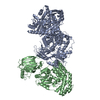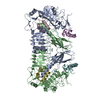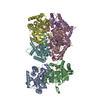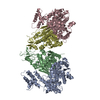[English] 日本語
 Yorodumi
Yorodumi- PDB-7mez: Structure of the phosphoinositide 3-kinase p110 gamma (PIK3CG) p1... -
+ Open data
Open data
- Basic information
Basic information
| Entry | Database: PDB / ID: 7mez | ||||||||||||||||||||||||||||||||||||
|---|---|---|---|---|---|---|---|---|---|---|---|---|---|---|---|---|---|---|---|---|---|---|---|---|---|---|---|---|---|---|---|---|---|---|---|---|---|
| Title | Structure of the phosphoinositide 3-kinase p110 gamma (PIK3CG) p101 (PIK3R5) complex | ||||||||||||||||||||||||||||||||||||
 Components Components |
| ||||||||||||||||||||||||||||||||||||
 Keywords Keywords | TRANSFERASE / PI3K / p110 / PIK3CG / PIK3R5 / p101 / phosphoinositide 3-kinase / PIP3 / IMMUNE SYSTEM | ||||||||||||||||||||||||||||||||||||
| Function / homology |  Function and homology information Function and homology informationnegative regulation of cardiac muscle contraction / negative regulation of triglyceride catabolic process / natural killer cell chemotaxis / secretory granule localization / neutrophil extravasation / phosphatidylinositol-4-phosphate 3-kinase / positive regulation of acute inflammatory response / 1-phosphatidylinositol-3-kinase regulator activity / respiratory burst involved in defense response / phosphatidylinositol 3-kinase complex ...negative regulation of cardiac muscle contraction / negative regulation of triglyceride catabolic process / natural killer cell chemotaxis / secretory granule localization / neutrophil extravasation / phosphatidylinositol-4-phosphate 3-kinase / positive regulation of acute inflammatory response / 1-phosphatidylinositol-3-kinase regulator activity / respiratory burst involved in defense response / phosphatidylinositol 3-kinase complex / T cell chemotaxis / negative regulation of fibroblast apoptotic process / phosphatidylinositol 3-kinase complex, class IB / regulation of calcium ion transmembrane transport / 1-phosphatidylinositol-4-phosphate 3-kinase activity / Co-stimulation by ICOS / sphingosine-1-phosphate receptor signaling pathway / phosphatidylinositol 3-kinase complex, class IA / phosphatidylinositol-3-phosphate biosynthetic process / 1-phosphatidylinositol-4,5-bisphosphate 3-kinase activity / phosphatidylinositol-4,5-bisphosphate 3-kinase / dendritic cell chemotaxis / phosphatidylinositol 3-kinase / 1-phosphatidylinositol-3-kinase activity / Erythropoietin activates Phosphoinositide-3-kinase (PI3K) / mast cell degranulation / phosphatidylinositol-mediated signaling / hepatocyte apoptotic process / regulation of cell adhesion mediated by integrin / phosphatidylinositol phosphate biosynthetic process / Synthesis of PIPs at the plasma membrane / positive regulation of MAP kinase activity / positive regulation of Rac protein signal transduction / CD28 dependent PI3K/Akt signaling / regulation of angiogenesis / T cell proliferation / ephrin receptor binding / GPVI-mediated activation cascade / neutrophil chemotaxis / positive regulation of endothelial cell migration / T cell activation / cellular response to cAMP / positive regulation of cytokine production / phosphatidylinositol 3-kinase/protein kinase B signal transduction / platelet aggregation / G-protein beta/gamma-subunit complex binding / endocytosis / Constitutive Signaling by Aberrant PI3K in Cancer / G beta:gamma signalling through PI3Kgamma / cell migration / PIP3 activates AKT signaling / positive regulation of cytosolic calcium ion concentration / PI5P, PP2A and IER3 Regulate PI3K/AKT Signaling / angiogenesis / phospholipase C-activating G protein-coupled receptor signaling pathway / adaptive immune response / non-specific serine/threonine protein kinase / positive regulation of phosphatidylinositol 3-kinase/protein kinase B signal transduction / protein kinase activity / immune response / G protein-coupled receptor signaling pathway / inflammatory response / innate immune response / protein serine kinase activity / protein serine/threonine kinase activity / ATP binding / identical protein binding / nucleus / membrane / plasma membrane / cytoplasm / cytosol Similarity search - Function | ||||||||||||||||||||||||||||||||||||
| Biological species |  Homo sapiens (human) Homo sapiens (human) | ||||||||||||||||||||||||||||||||||||
| Method | ELECTRON MICROSCOPY / single particle reconstruction / cryo EM / Resolution: 2.89 Å | ||||||||||||||||||||||||||||||||||||
 Authors Authors | Burke, J.E. / Dalwadi, U. / Rathinaswamy, M.K. / Yip, C.K. | ||||||||||||||||||||||||||||||||||||
| Funding support |  Canada, 1items Canada, 1items
| ||||||||||||||||||||||||||||||||||||
 Citation Citation |  Journal: Structure / Year: 2021 Journal: Structure / Year: 2021Title: HDX-MS-optimized approach to characterize nanobodies as tools for biochemical and structural studies of class IB phosphoinositide 3-kinases. Authors: Manoj K Rathinaswamy / Kaelin D Fleming / Udit Dalwadi / Els Pardon / Noah J Harris / Calvin K Yip / Jan Steyaert / John E Burke /   Abstract: There is considerable interest in developing antibodies as modulators of signaling pathways. One of the most important signaling pathways in higher eukaryotes is the phosphoinositide 3-kinase (PI3K) ...There is considerable interest in developing antibodies as modulators of signaling pathways. One of the most important signaling pathways in higher eukaryotes is the phosphoinositide 3-kinase (PI3K) pathway, which plays fundamental roles in growth, metabolism, and immunity. The class IB PI3K, PI3Kγ, is a heterodimeric complex composed of a catalytic p110γ subunit bound to a p101 or p84 regulatory subunit. PI3Kγ is a critical component in multiple immune signaling processes and is dependent on activation by Ras and G protein-coupled receptors (GPCRs) to mediate its cellular roles. Here we describe the rapid and efficient characterization of multiple PI3Kγ binding single-chain camelid nanobodies using hydrogen-deuterium exchange (HDX) mass spectrometry (MS) for structural and biochemical studies. We identify nanobodies that stimulated lipid kinase activity, block Ras activation, and specifically inhibited p101-mediated GPCR activation. Overall, our work reveals insight into PI3Kγ regulation and identifies sites that may be exploited for therapeutic development. | ||||||||||||||||||||||||||||||||||||
| History |
|
- Structure visualization
Structure visualization
| Movie |
 Movie viewer Movie viewer |
|---|---|
| Structure viewer | Molecule:  Molmil Molmil Jmol/JSmol Jmol/JSmol |
- Downloads & links
Downloads & links
- Download
Download
| PDBx/mmCIF format |  7mez.cif.gz 7mez.cif.gz | 292.3 KB | Display |  PDBx/mmCIF format PDBx/mmCIF format |
|---|---|---|---|---|
| PDB format |  pdb7mez.ent.gz pdb7mez.ent.gz | 226.6 KB | Display |  PDB format PDB format |
| PDBx/mmJSON format |  7mez.json.gz 7mez.json.gz | Tree view |  PDBx/mmJSON format PDBx/mmJSON format | |
| Others |  Other downloads Other downloads |
-Validation report
| Summary document |  7mez_validation.pdf.gz 7mez_validation.pdf.gz | 867.5 KB | Display |  wwPDB validaton report wwPDB validaton report |
|---|---|---|---|---|
| Full document |  7mez_full_validation.pdf.gz 7mez_full_validation.pdf.gz | 886.6 KB | Display | |
| Data in XML |  7mez_validation.xml.gz 7mez_validation.xml.gz | 49.7 KB | Display | |
| Data in CIF |  7mez_validation.cif.gz 7mez_validation.cif.gz | 76.4 KB | Display | |
| Arichive directory |  https://data.pdbj.org/pub/pdb/validation_reports/me/7mez https://data.pdbj.org/pub/pdb/validation_reports/me/7mez ftp://data.pdbj.org/pub/pdb/validation_reports/me/7mez ftp://data.pdbj.org/pub/pdb/validation_reports/me/7mez | HTTPS FTP |
-Related structure data
| Related structure data |  23808MC M: map data used to model this data C: citing same article ( |
|---|---|
| Similar structure data |
- Links
Links
- Assembly
Assembly
| Deposited unit | 
|
|---|---|
| 1 |
|
- Components
Components
| #1: Protein | Mass: 126627.406 Da / Num. of mol.: 1 Source method: isolated from a genetically manipulated source Source: (gene. exp.)  Homo sapiens (human) / Gene: PIK3CG / Production host: Homo sapiens (human) / Gene: PIK3CG / Production host:  References: UniProt: P48736, phosphatidylinositol 3-kinase, phosphatidylinositol-4,5-bisphosphate 3-kinase, phosphatidylinositol-4-phosphate 3-kinase, non-specific serine/threonine protein kinase |
|---|---|
| #2: Protein | Mass: 97471.805 Da / Num. of mol.: 1 / Mutation: G473R, V530A Source method: isolated from a genetically manipulated source Source: (gene. exp.)   |
| Has protein modification | N |
-Experimental details
-Experiment
| Experiment | Method: ELECTRON MICROSCOPY |
|---|---|
| EM experiment | Aggregation state: PARTICLE / 3D reconstruction method: single particle reconstruction |
- Sample preparation
Sample preparation
| Component | Name: Ternary complex of p110 gamma with p101 and a p101 binding nanobody Type: COMPLEX Details: Nanobody binds to GBD domain, but was too fleixble to be built in the atomic model Entity ID: all / Source: RECOMBINANT | |||||||||||||||||||||||||
|---|---|---|---|---|---|---|---|---|---|---|---|---|---|---|---|---|---|---|---|---|---|---|---|---|---|---|
| Molecular weight | Experimental value: NO | |||||||||||||||||||||||||
| Source (natural) |
| |||||||||||||||||||||||||
| Source (recombinant) | Organism:  | |||||||||||||||||||||||||
| Buffer solution | pH: 8.5 Details: Freshly prepared gel filtration buffer, filtered through 0.22um filter and degassed | |||||||||||||||||||||||||
| Buffer component |
| |||||||||||||||||||||||||
| Specimen | Conc.: 0.45 mg/ml / Embedding applied: NO / Shadowing applied: NO / Staining applied: NO / Vitrification applied: YES Details: Specimen was a 1:1:1 molar ratio of p110g-p101-nanobody, purified to homogeneity by gel filtration. | |||||||||||||||||||||||||
| Specimen support | Details: Glow discharged using the Pelco EasiGlow. 15mA Current. Grid material: COPPER / Grid mesh size: 300 divisions/in. / Grid type: C-flat-2/2 | |||||||||||||||||||||||||
| Vitrification | Instrument: FEI VITROBOT MARK IV / Cryogen name: ETHANE / Humidity: 100 % / Chamber temperature: 277 K / Details: 1.5s blot time, -5 blot force |
- Electron microscopy imaging
Electron microscopy imaging
| Experimental equipment |  Model: Titan Krios / Image courtesy: FEI Company |
|---|---|
| Microscopy | Model: FEI TITAN KRIOS |
| Electron gun | Electron source:  FIELD EMISSION GUN / Accelerating voltage: 300 kV / Illumination mode: FLOOD BEAM FIELD EMISSION GUN / Accelerating voltage: 300 kV / Illumination mode: FLOOD BEAM |
| Electron lens | Mode: BRIGHT FIELD / Nominal defocus max: 2400 nm / Nominal defocus min: 1000 nm / Cs: 2.7 mm |
| Specimen holder | Cryogen: NITROGEN / Specimen holder model: FEI TITAN KRIOS AUTOGRID HOLDER |
| Image recording | Electron dose: 36.4 e/Å2 / Film or detector model: GATAN K3 BIOQUANTUM (6k x 4k) / Num. of grids imaged: 1 / Num. of real images: 6808 Details: Movies were collected in super-resolution mode set to collect 3 shots per grid hole over 9 holes by beam-shift before applying a stage shift. |
| EM imaging optics | Energyfilter name: GIF Bioquantum / Energyfilter slit width: 20 eV |
- Processing
Processing
| Software | Name: PHENIX / Version: 1.19.1_4122: / Classification: refinement | ||||||||||||||||||||||||||||
|---|---|---|---|---|---|---|---|---|---|---|---|---|---|---|---|---|---|---|---|---|---|---|---|---|---|---|---|---|---|
| EM software |
| ||||||||||||||||||||||||||||
| Image processing | Details: All data processing carried out using cryoSPARC v2.18 or newer. Movies were subjected to patch motion correction and 2x2 binning. CTFs of the resulting micrographs were estimated using patch ...Details: All data processing carried out using cryoSPARC v2.18 or newer. Movies were subjected to patch motion correction and 2x2 binning. CTFs of the resulting micrographs were estimated using patch CTF estimation. Template picking using 2D averages low-pass filtered to 20A was carried out before 1 round of 2D and 1 round of 3D classification. Best particles were refined by local motion correction, then subjected to 1 more round of 3D classification. Best class/particles were refined by homogeneous refinement, followed by CTF/defocus refinement and a final non-uniform refinement step. | ||||||||||||||||||||||||||||
| CTF correction | Type: PHASE FLIPPING AND AMPLITUDE CORRECTION | ||||||||||||||||||||||||||||
| Particle selection | Num. of particles selected: 3762631 Details: Particles were picked using the cryoSPARC template picker | ||||||||||||||||||||||||||||
| Symmetry | Point symmetry: C1 (asymmetric) | ||||||||||||||||||||||||||||
| 3D reconstruction | Resolution: 2.89 Å / Resolution method: FSC 0.143 CUT-OFF / Num. of particles: 320179 / Details: cryoSPARC local refinement job (L) from v3.0 / Num. of class averages: 1 / Symmetry type: POINT | ||||||||||||||||||||||||||||
| Refine LS restraints |
|
 Movie
Movie Controller
Controller










 PDBj
PDBj



